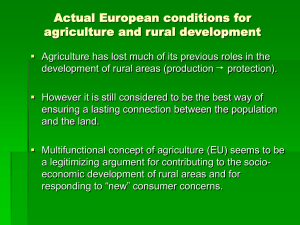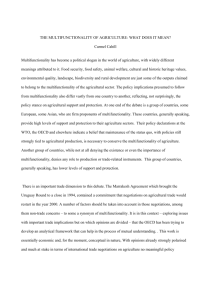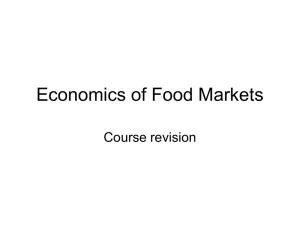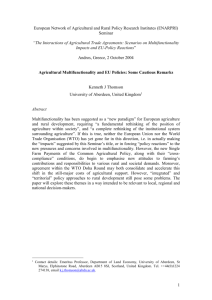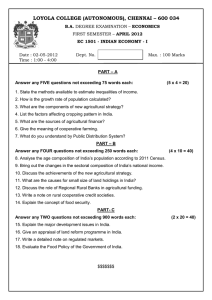Multifunctionality refers to the fact that an economic activity may
advertisement
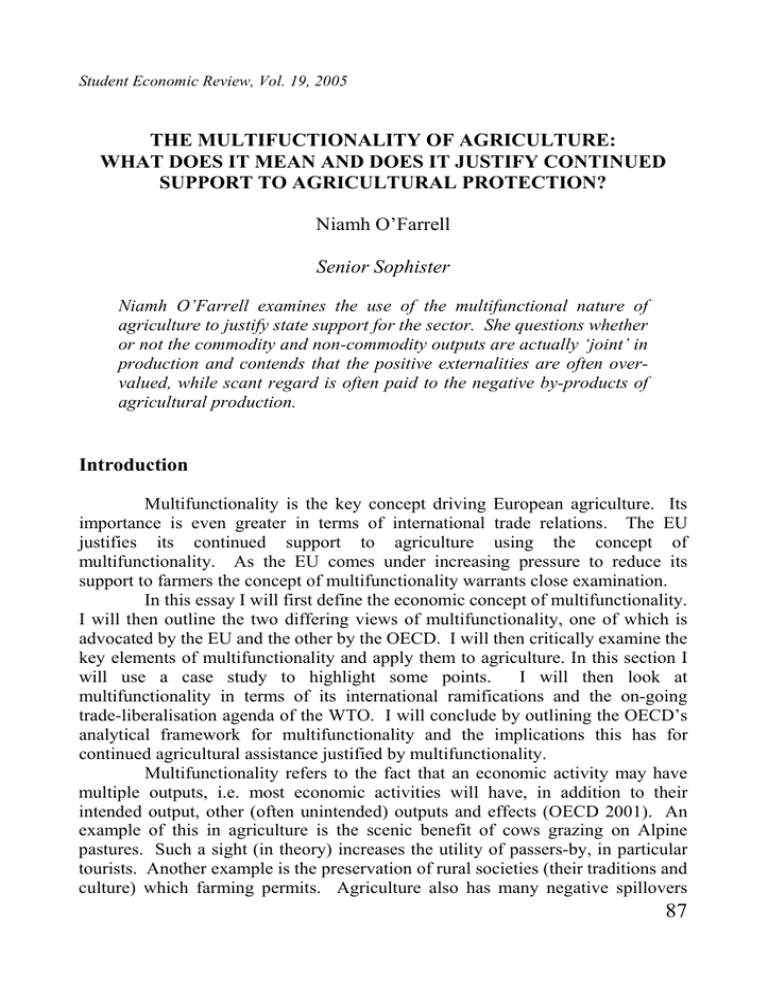
Student Economic Review, Vol. 19, 2005 THE MULTIFUCTIONALITY OF AGRICULTURE: WHAT DOES IT MEAN AND DOES IT JUSTIFY CONTINUED SUPPORT TO AGRICULTURAL PROTECTION? Niamh O’Farrell Senior Sophister Niamh O’Farrell examines the use of the multifunctional nature of agriculture to justify state support for the sector. She questions whether or not the commodity and non-commodity outputs are actually ‘joint’ in production and contends that the positive externalities are often overvalued, while scant regard is often paid to the negative by-products of agricultural production. Introduction Multifunctionality is the key concept driving European agriculture. Its importance is even greater in terms of international trade relations. The EU justifies its continued support to agriculture using the concept of multifunctionality. As the EU comes under increasing pressure to reduce its support to farmers the concept of multifunctionality warrants close examination. In this essay I will first define the economic concept of multifunctionality. I will then outline the two differing views of multifunctionality, one of which is advocated by the EU and the other by the OECD. I will then critically examine the key elements of multifunctionality and apply them to agriculture. In this section I will use a case study to highlight some points. I will then look at multifunctionality in terms of its international ramifications and the on-going trade-liberalisation agenda of the WTO. I will conclude by outlining the OECD’s analytical framework for multifunctionality and the implications this has for continued agricultural assistance justified by multifunctionality. Multifunctionality refers to the fact that an economic activity may have multiple outputs, i.e. most economic activities will have, in addition to their intended output, other (often unintended) outputs and effects (OECD 2001). An example of this in agriculture is the scenic benefit of cows grazing on Alpine pastures. Such a sight (in theory) increases the utility of passers-by, in particular tourists. Another example is the preservation of rural societies (their traditions and culture) which farming permits. Agriculture also has many negative spillovers 87 THE MULTIFUNCTIONALITY OF AGRICULTURE such as pollution and land erosion; I will return to this issue later. The multifunctional nature of agriculture has, in recent years, become a hotly debated issue. However as the opening definition suggests, the term does not relate solely to agriculture. Why then has the multifunctional nature of agriculture aroused such interest and controversy? The OECD suggests that the spillover effects of agriculture, such as its effect on rural employment and sustainability, and its effect on the environment, are more important than those of other sectors of the economy. More skeptical commentators suggest that multifunctionality is used as a pretext for continued agricultural protection. The OECD outlines the two main approaches to multifunctionality. The first is to interpret multifunctionality as a characteristic of an economic activity. An economic activity’s multiple, interrelated outputs or effects are what give it its multifunctional character. These outputs can be intentional or unintentional, positive or negative, complementary or conflicting. Some of the outputs are valued in existing markets, while others evade the market mechanism. Multifunctionality interpreted in this way is not specific to agriculture, and there is no implicit notion that all economic activities must be multifunctional. This view can be termed the ‘positive’ concept of multifunctionality. The positive approach is the one chosen by the OECD. The second way of interpreting multifunctionality is in terms of the multiple roles assigned to agriculture. In this view, agriculture is seen to have the role of fulfilling certain roles in society. As such, multifunctionality is not just seen as a characteristic of the production process, but it takes on a value itself. Maintaining a multifunctional activity or making an activity which is ‘more’ multifunctional can become a policy objective. This view can be termed the ‘normative’ concept of multifunctionality. It is clear from the EU’s comments on multifunctionality that it has a normative approach to multifunctionality: “Apart from its production function, agriculture encompasses other functions such as the preservation, management and enhancement of the rural landscape, the protection of the environment… These functions are not simply externalities of the agricultural production function, i.e. undirected side-effects, not embedded into an institutional and political context. It is a fact that European society does care about the multiple functions of agriculture and therefore policies to ensure their supply have been established” (European Commission Oct. 1999). 88 NIAMH O’FARRELL The two approaches, while not mutually exclusive,1 highlight the difference in views on the importance of agriculture’s multifunctional nature. For the purpose of this essay I will focus on the OECD’s positive approach. The two key elements of multifunctionality are firstly the existence of multiple commodity and noncommodity outputs that are jointly produced by agriculture and secondly the fact that some of the non-commodity outputs exhibit the characteristics of externalities or public goods, with the result that markets for these goods do not exist or function poorly (OECD 2001). I will now look at each of these aspects in turn. Jointness Joint production refers to situations where a firm produces two or more outputs that are interlinked so that an increase or decrease in the supply of one output affects levels of the others (OECD 2001). Multifunctionality hinges on the concept of jointness as, without it, there is no technical or economic link between the commodity and the non-commodity outputs and thus no agricultural policy issue to be explored. If jointness does not exist it is possible to provide nonagricultural provision without agricultural production taking place. But even if separation of the commodity and non-commodity outputs is technically possible, it may still make sense to produce the products jointly due to ‘economies of scope.’ This means that joint production of two or more commodities is cheaper than separate production. On the other hand, if jointness does exist, it may confer a cost advantage i.e. the production of the non-commodity output is cheaper when it is produced with the agricultural commodity. Examples of jointness in agriculture are rural employment and the maintenance of landscape. However jointness is often assumed when in reality it is dubious. An obvious example of where jointness does not exist is in the maintenance of historical buildings and cultural heritage sights. These sights can be maintained irrespective of agricultural activity. The sustainability of rural communities resulting from rural employment generated by agriculture is often put forward as one of the more ‘obvious’ multifunctional outputs of agriculture. In fact in developed countries increases in agricultural output and employment are inversely correlated. This is due to advances in technology and the mechanisation of jobs. Jointness between agriculture and rural sustainability through employment is therefore not a clear-cut issue. 1 The OECD states that a positive approach does not exclude a discussion of the normative approach to multifunctionality. 89 THE MULTIFUNCTIONALITY OF AGRICULTURE Along with rural employment, the preservation of the environment is cited as one of agriculture’s multifunctional characteristics. However, as with employment, this assumption is far from clear. Additionally, as mentioned earlier, agriculture has numerous negative spillovers. Intensive farming was in fact a direct result of CAP payments. Farmers were paid guaranteed prices for their agricultural produce, which served as an incentive to increase farm inputs (such as fertilizer) beyond the normal returns dictated by the market. The results of such practices led to soil erosion and large fields with few trees or hedges. Excessive amounts of fertilizer led to pollution of soil and water and unpleasant smells. On the other hand, there are examples of agriculture having positive spillover effects, such as rice production on terraced paddy fields which is credited with preventing soil erosion and flood prevention. Food security is also mentioned as an important multifunctional benefit of agriculture. However this argument is of decreasing importance for most developed countries especially given that most countries import a large proportion of their food anyway. Winters (1987) states that if food security really mattered to industrialised countries they would tackle it via strategic stockpiles rather than output policies. Food security remains an important issue for Less Developed Countries (LDCs) however. Alas, in most cases their food security issues have more to do with non-agricultural factors such as lack of inputs and poorly developed distribution and transportation systems. The above examples show that the issue of jointness - a central tenet of multifunctionality - is far from a tightly defined, easily quantifiable issue. In many cases the non-commodity outputs of agriculture can in fact be produced independently of agriculture. In other cases the spillovers from agriculture have negative effects. Jointness is a critical concept as the extent of jointness creates opportunities for and impediments to policy targeting and decoupling (Cahill 2000). If multifunctionality is used to justify continued support to agriculture yet one of its central tenets is highly questionable, then one must conclude that justifying support based on it is very problematic. Externalities and the public good nature of multifunctionality The elements of multifunctional agriculture are externalities and, in most cases, public goods that are produced jointly with food in agricultural processes (OECD 2001). Therefore, these effects do not have a monetary value and no compensation is paid for producing them. Governments, and more particularly the EU, regard agricultural support as an indirect form of payment to farmers for providing these non-commodity outputs. As I have previously outlined the 90 NIAMH O’FARRELL problems with jointness in agriculture, I will now look at the issues associated with government provision of public goods. The multifunctional nature of agriculture provides various public goods, for example the preservation of rural communities and landscapes. These multifunctional aspects of agriculture are valued by society and, as such, a case could be made to justify continued agricultural support. An externality is a cost or benefit arising from any activity which does not accrue to the person carrying out the activity. For example the effects of pesticide use on the biodiversity of agricultural land is an externality produced by agriculture. The non-commodity outputs from agriculture are, for the most part, public goods. Public goods are by definition non-rival in consumption and their benefits are non-excludable. Non-rival means that one agent consuming a commodity does not prevent other agents from consuming the same product (examples from outside of agriculture include street lighting and national defense). Non-excludable means it is not possible to hinder any agent’s consumption of a public good. These two characteristics mean that no markets exist for public goods, thus it is necessary for governments to intervene in the market to ensure the optimal provision of those goods. Examples of public goods in agriculture would be the preservation of traditional farming techniques and culture and the preservation of the environment. The EU regards agriculture as part of its formative history and as such wishes to preserve it. The environmental ‘benefits’ related to the multifunctionality of agriculture as I stated earlier are dubious as many of these supposed public goods are in fact negative externalities. Agricultural support is not by any means the most efficient way of providing such public goods. I will prove this point in two ways: first, using a case study and second by giving examples of cases where direct payments are the best incentive for providing public goods. Yrjölä and Kola conducted a survey of consumers’ attitudes towards and willingness to pay (WTP) for the multifunctional elements of agriculture (2004). The survey was conducted using the contingent valuation (CV) method, which elicits consumer preferences for public goods by constructing a hypothetical market for the public good. The aim of the CV study was to estimate consumers WTP for the public goods by asking them how much they would pay for certain government actions. Yrjölä and Kola’s survey was conducted using questionnaires on a computer aided interviewing system. The households surveyed were selected on demographic grounds and were considered a representative sample of all Finnish citizens of 18 to 75 years of age. The results showed that food safety and welfare of animals were considered very important issues the most often, the state of the rural environment was considered to be important, and the maintenance of 91 THE MULTIFUNCTIONALITY OF AGRICULTURE the rural landscape was considered to be the least important element of multifunctionality. When citizens were asked about the key roles of agriculture in society at large the ensuring of viable and permanent settlement in rural areas and the adequate production of healthy and high quality food products were regarded as being the most important aspects of Finnish agriculture. The average WTP for multifunctional agriculture was roughly €94 per citizen per year. The aggregate WTP for an optimal bunch of multifunctional agriculture varies between €189mn and €377mn. The annual amount of agricultural support in Finland in 2003 was €1.79bn. If multifunctionality is used as the sole justification for agricultural support then in this case the government is over-valuing its benefits enormously. Even allowing for such caveats as the likelihood of citizens to under-value public goods, the difference between the two amounts is vast. The above case study highlights how costly current agricultural support is, and how it pays excessive amounts for the desired benefits of multifunctionality. The only way in which multifunctionality would justify continued agricultural support would be if the supports were more efficient and directly aimed at preserving the public goods valued by society. Aside from the fact that the jointness between commodity and non-commodity outputs is highly disputed, it is possible to produce the desired non-commodity outputs independently of production, and indeed in a more cost effective way. For example Japan currently supports its rice producers to the tune of six times world market price. Part of the justification for this is that paddy fields are multifunctional in the sense that they prevent soil erosion and flooding. There are however a range of alternatives that can provide the same benefit. Such alternatives, like chemically leaching ground water tables are significantly less expensive than providing agricultural support to farmers. If governments want to reward rice farmers for their contribution to flood control they could do so directly i.e. by provide cash payments for each acre cultivated as opposed to broad agricultural support (ABARE Aug 1999). Conclusions Against the backdrop of continued WTO negotiations calling for increased trade liberalization the EU’s trading partners are suspicious of multifunctionality being used in a blanket fashion to justify all agricultural support. Indeed, as Swinbank notes it was the need to engage in a new round of agricultural trade negotiations that brought multifunctionality to the fore (2001). The EU has made extensive use of the ‘green box’ policies, which are agricultural 92 NIAMH O’FARRELL supports deemed acceptable by the international community, i.e. supports that are minimally trade distorting. Supports aimed at the non-commodity outputs of agriculture fall into this box. The EU has been able to move expenditure from the constrained amber box to the unconstrained blue and green boxes. This has led the EU’s critics, particularly in developing countries, to conclude that the rules are too lax. Coupled with this administrative loophole is the poorly defined concept of multifunctionality, which is often employed as a justification for blanket support. In this essay I have shown that the tenets upon which multifunctionality is based are far from definitive. The OECD analytical framework provides us with three key questions that allow us to evaluate what the optimal intervention should be: • • • Is the non-commodity output jointly produced with an agricultural commodity and, if so, to what degree can its link with commodity production be changed? Is there market failure? Have non-government options such as market creation or voluntary provision been explored as the most efficient strategy? (2001) These criteria highlight the importance of the concepts of jointness and public goods in the multifunctionality debate. I have outlined the problems pertaining to both. Jointness between commodity and non-commodity outputs is highly questionable. Externalities can be both positive and negative, with the latter causing serious damage to the environment and in many cases over-riding the assumed ‘positive’ externalities. Government provision of public goods is also problematic for two main reasons. Firstly, it is very difficult to value public goods and this can lead to under or over supply. Secondly, government expenditure is influenced by bureaucratic and political pressures, which can have little if any correlation to public demand for such goods. This fact is a noteworthy aspect of multifunctionality. Agricultural support is greatly influenced by domestic politics and interest groups. As Winters notes pressure groups for agriculture are widely believed to be the most organized and most influential in Western economies (1987). According to Winters “Policy-makers tend to favor complex and obscure methods of intervention whose costs are hidden, but whose benefits are plain” (ibid). One can easily apply this to multifunctionality. The benefits seem to be clear to the uninformed observer i.e. agricultural support helps maintain the viability of rural areas. However on closer inspection one can conclude such benefits are not as forthcoming as policy-makers claim and that multifunctionality is an inefficient and expensive way to provide non-commodity outputs. Providing 93 THE MULTIFUNCTIONALITY OF AGRICULTURE blanket agricultural support to farmers with the aim of providing the optimum amount of non-commodity outputs is indeed a ‘complex and obscure method.’ Providing direct and targeted payments for non-commodity outputs, regardless of jointness, is a more transparent, effective, and efficient means of ensuring supply of these non-commodities. Lastly, I would like to comment on the concept of agriculture contributing to rural economies. Agriculture is a sector with many structural problems such as declining prices, low elasticity of demand etc. Indeed it is well documented that many European farms would have disappeared long ago had it not been for the generous CAP. Given these facts I find the idea of agriculture single-handedly propping-up the economies of rural areas extremely problematic. I think that the European model of agriculture is, in many ways, romantic and ultimately unrealistic. In my opinion the rural communities of the EU, and indeed worldwide, need a modern economic approach to tackle their problems. Such an approach would have numerous polices targeting all sectors of the rural economy, not just agriculture. If rural communities are to be maintained I believe that such a multi-pronged approach is necessary. Rural viability should not be used as a synonym for agricultural support, especially when such support is unrealistic. To conclude, I believe the present system of agricultural support is not justified by multifunctionality. Bibliography ABARE (1999) Multifunctionality - A Pretext for Protection, November. The Australien Bureau of Agricultural Economics. Abler, D. (2002) Multifunctionality: The question of jointness: Applying the OCED framework-A review of literature in the United States. Paris: OECD <www.oecd.org/agr/mf/doc/usa_abler_revised.pdf>. Cahill, C. and Shobayashi, M. (2000) The Concept of Multifunctionality of Agriculture: Results of OECD Research. Paper to the Agricultural Economics Society of Ireland. European Commission – Directorate General of Agriculture, Stella Zervoudaki, ed. (1999), Contribution of the European Community on the Multifunctional Character of Agriculture, Oct. Brussels: European Commission Info-Paper. <www.eu.int/comm/agriculture/external/wto/document/ip2_en.pdf >. 94 NIAMH O’FARRELL OECD (2001) Multifunctionality: Towards an Analytical Framework. France: OECD Publications. Prestegard, S. (2003) Policy Measures to Enhance a Multifunctional Agriculture: Applications to the WTO Negotiations on Agriculture. Oslo: Norwegian Agricultural Economics Research Institute <www.ecostat.unical.it/2003 agtradeconf/ contributed%20papers/prestegard.pdf>. Prestegard, S. (2004) Multifunctional agriculture and the design of policy instruments: Application to the WTO negotiations on agriculture. Oslo: Norwegian Agricultural Economics Research Institute <www.nilf.no/publikasjoner/notate r/en/2004 /n 200408hele.pdf>. Swinbank, A. (2001) Multifunctionality: A European Euphemism for Protection? University of Reading <www.apd.rdg.ac.uk/agecon/ research/ working papers/as1.pdf>. Winters, A. (1987) The Political Economy of Industrial Countries’ Agricultural Policy. France: OECD Publications. Winters, A. (1990) The So-Called “Non-Economic” Objectives of Agricultural Support. France: OECD Economic Studies 13. Yrjölä, T. & Kola, J. (2004) Preferences of Consumers in terms of Multifunctional Agriculture. Helsinki: University of Helsinki <www.ifama.org/confere nces/2004conference/paper s/kola 1040.pdf >. 95

